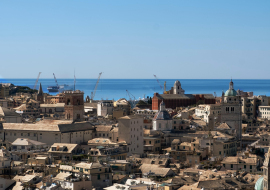
How to get rid of salt deposits in the house

Having a home by the sea and being able to go there whenever you want can be a real dream, especially in the summer when the temperature in the cities rises and the only thing you want to do is be on the beach and dive into the water to cool off. However, this dream may lose its appeal when it comes time to clean the house.
In coastal areas, knowing how to get rid of salt deposits in your home can be key to reducing time spent on household chores, allowing you to spend the rest of your day relaxing. For less severe cases, dusting surfaces with talcum powder and then cleaning them with a mixture of warm water and white vinegar is a natural and effective method.
How to Remove Salt Plaque Salty sea air laden with salt can seriously damage the materials used to build homes, increasing wear and tear and erosion. Knowing how to remove salt buildup is helpful in preventing these problems.
Building facades facing the sea are particularly vulnerable and require additional protection, such as the use of sustainable materials and wind barriers. In addition, oxidation from salt is especially problematic for metals that require protective treatments and regular monitoring.
How to remove salt deposits from metal One of the materials most susceptible to salt deposits is metal, especially iron, copper and their alloys such as bronze, cast iron and steel. Iron is prone to rust, losing its shape and mechanical properties, while copper develops a greenish patina. Even galvanized iron that has been treated to resist corrosion can suffer if exposed to salt deposits for long periods of time without proper care.
Exposed structures such as railings and window frames are especially vulnerable to corrosion caused by salt deposits, which act as a conductor of electricity, creating small currents that accelerate the degradation of metals. It is therefore important to regularly check the condition of metals and only use suitable materials such as brass and aluminum that are resistant to salt deposits.
To remove salt deposits from metal surfaces, it is recommended:
- Remove dust and sand with a damp cloth;
- In case of plaque, use an iron sponge soaked in a solution of warm water and degreaser.
For wooden window frames, instead of using abrasive sponges, it is better to choose a special detergent with a washing and protective effect. Finally, to remove any remaining salt deposits, wipe all treated surfaces with a damp cloth.
How to remove salt deposits from window panes Salt deposits also settle on window panes. Therefore, if you have a home by the sea, it is important to clean the glass correctly. One of the most effective methods is to use a mixture of lemon, water and three drops of dishwashing detergent. After applying the mixture, you need to wash it off with a damp cloth and dry the newspapers so that the glass becomes shiny and streak-free. As an alternative, you can use special universal glass cleaners.
It is important to choose the right time of day to clean your glass, preferably early in the morning or at sunset, to avoid surfaces drying out quickly in direct sunlight, which can cause frosted marks.
How to remove salt deposits from walls To remove salt deposits from walls, you first need to thoroughly clean the surface with a stiff brush to remove visible salt deposits. Then you can treat the surface with special solutions.
Regular maintenance and periodic inspection of the walls are necessary to ensure that salt deposits do not cause serious structural damage.
How to remove salt deposits from gates To remove salt deposits from gates, often made of metal, you need to clean the surface with a stiff brush to remove visible deposits. Metal, especially iron, is very susceptible to corrosion due to salt deposits, so it is important to take action quickly.
One effective solution is to prepare a mixture of warm water and degreaser, which must be applied to all areas to be treated. After this, rinse the mixture thoroughly to remove any remaining salt and detergent.
After cleaning, it is recommended to dry the gate thoroughly with a soft cloth to avoid the re-formation of salt deposits. It is also advisable to carry out regular inspections and apply anti-corrosion agent or protective paint to prevent possible future damage.
News

23/08/2024
Why are the fuses blown?

21/08/2024
Life in Castelletto

19/08/2024
How to Stop a Cat from Running Away

09/08/2024
6 Most Beautiful Beaches in Genoa

08/08/2024
How is Ferragosto celebrated in Italy?

05/08/2024